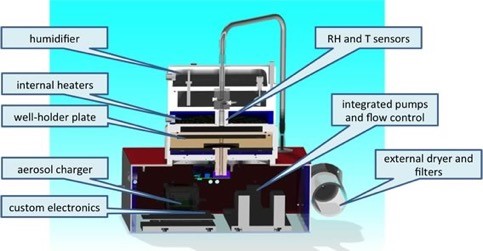Health relevant aerosol components: online instrument development, lab and field studies
Epidemiological studies have shown consistently positive correlations between aerosol particle exposure and a range of adverse health effects. The World Health Organisation (WHO) lists air pollution particles as the most pressing public health issue, accounting for ca. 5% of all deaths worldwide. Despite a large number of studies on atmospheric particle toxicity, the biological pathways causing the adverse health effects of particulate air pollution are poorly understood and there is no conclusive evidence as to which particle properties are causing their toxicity. Chemical particle components are likely a key factor, but are difficult to accurately define. Identifying health-relevant particle parameters, components and ultimately sources would be crucial for improved and efficient air pollution mitigation strategies.
Atmospheric aerosol particles contain a range of oxidising aerosol components (i.e. Reactive Oxygen Species (ROS) or Oxidative Potential (OP)), which are potentially toxic as they can oxidise biological molecules at the liquid lung surface layer or generate oxidising components once deposited on the lung surface. From an analytical point of view, it is highly challenging to quantify these oxidising particle components as some of them have short lifetimes requiring fast measurement techniques.
Reactive Oxygen Species, ROS
We are developing and deploying a novel instrument to quantify ROS as a sum parameter with a technique that captures reactive and short-lived ROS components immediately after being pumped into the instrument. This new instrument has a time resolution of about 5 minutes and is sensitive enough to characterise ROS concentrations and evolution in laboratory and field experiments.
Nanoparticle toxicity: particle – lung cell culture online deposition chamber
We built a unique instrument which allows to deposit aerosol particles in the nm size range efficiently and evenly onto cell cultures. This process mimics accurately the in vivo physiological conditions and particle deposition in the human lung. In collaboration with cell biologists and toxicologists we are investigating the effects of particle composition and particle source on the biochemical and physiological responses of lung cells.
Responsible team members
Related Publications
Campbell, S., Utinger, B., Lienhard, D.M., Paulson, S.E., Shen, J., Griffiths, P.T., Stell, A.S. and Kalberer, M., Anal. Chem. 2019, 91, 20, 13088–13095. https://doi.org/10.1021/acs.analchem.9b03282
Wragg F. P. H. et al., An Automated On-line Instrument to Quantify Aerosol-Bound Reactive Oxygen Species (ROS) for Ambient Measurement and Health Relevant Aerosol Studies, Atmos. Meas. Tech., 9, 4891–4900, 2016. https://doi.org/10.5194/amt-9-4891-2016
Künzi L. et al., Toxicity of aged gasoline exhaust particles to normal and diseased airway epithelia, Nature Scientific Reports, 5, doi:10.1038/srep11801, 2015. https://doi.org/10.1038/srep11801
Platt S.M. et al., Two-stroke scooters are a dominant source of air pollution in many cities, Nature Communications, DOI: 10.1038/ncomms4749, 2014. https://doi.org/10.1038/ncomms4749
Mertes P. et al., A novel deposition chamber for nanoparticle – lung interaction studies, J Aerosol Medicine and Pulmonary Drug Delivery, DOI: 10.1089/jamp.2012.0985, 2013. https://doi.org/10.1089/jamp.2012.0985
Quick Links
Social Media


